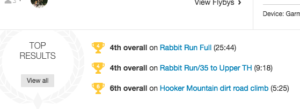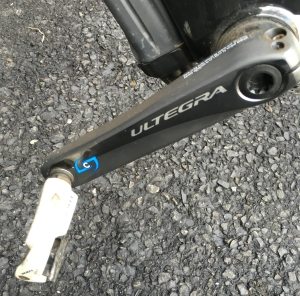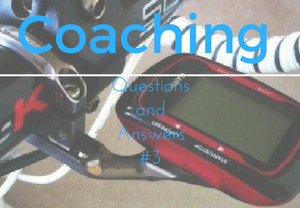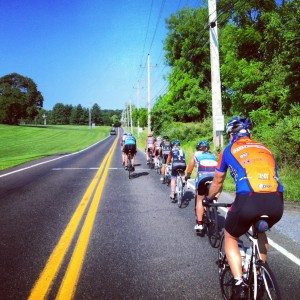As an online cycling coach, I get a lot of questions emailed to me. Every so often, I take a sampling of those questions and answer them for the benefit of everyone who listens to the Tailwind Coaching Podcast.
In this Q&A episode, I'll tackle plenty of training and fitness questions. If you've ever been dropped on a group ride, you'll want to check out what I have to say. Some others have been confused as to the best way to test functional threshold power or evaluate their performance improvements. Folks from the southern hemisphere will be pleased to learn about training in the heat. Beginners get some love with some questions about riding harder vs riding longer and Gran Fondo and long distance racers get some attention with a discussion about long distance training. Finally, check out a basic power meter setup with a question about the bare minimum you need to start training with power.
Without further ado…
Coaching Questions and Answers
Below you'll find some links and information to expand on what I've covered in this podcast. 464yepvn
Podcast: Play in new window | Download (45.6MB)
Subscribe: RSS
Getting dropped on group rides:
“I'm finding that I'm getting dropped on my group rides and races. I look around and everyone seems to be riding at a lot less effort. Even some of my teammates have shared their power data with me and I'm putting out between 30 and 40 more watts than them on the same rides, but I'm still getting dropped. How can I stay with them a little better? Do I need more training or a different bike? Thanks!”
There's a lot of factors that go into how efficient you are. Some of these include the tire pressure you're running, the kind of chain lube you're using, how aerodynamic you are and how efficient your body is. In terms of aerodynamics, you can make a couple of quick observations about how aero you really are. Specialized reported that you can save around 70 seconds over 40K by simply shaving your legs. Having your jersey loose, baggy or flapping in the breeze will increase your aerodynamic drag significantly. The moral of the story here is zip up that jersey and buy one that's properly sized in the first place.
Wheels and tires can have a significant impact on aerodynamics, but the cost/benefit ratio for swapping out your wheels is pretty slim. On the converse side, swapping tires alone can improve your efficiency significantly. The wider the tire and the more supple the casing, the less vibration is transmitted through to your body. The decrease in vibration results in less energy wasted to combat that vibration. In addition, the lower pressure, wider tire has lower rolling resistance, so less energy is wasted in friction between your tire and the ground. Look for a good quality, supple pair of tires and cut the air pressure down a bit. I'm fond of the [easyazon_link identifier=”B00G8QGTY6″ locale=”US” tag=”taicoaandthed-20″]Continental GP4000S II[/easyazon_link] for this particular application. If you're riding on rough surfaces, give a look to the [easyazon_link identifier=”B01ACFWBPO” locale=”US” tag=”taicoaandthed-20″]Vittoria Corsa G+ Graphene[/easyazon_link] line.
Chain lube can net you a few watts of savings as well. I detailed my favorite chain lube process a couple months ago, and I still think it's a great choice if you're willing to invest the time. It can save you a few watts of energy, keeping you fresher throughout a ride.
Finally, muscular efficiency and group ride tactics are hugely important to your ability to stay together with any group you ride with. You can check out some of my tips for effective group riding here, and learn about efficiency in this podcast.
The best way to test your functional threshold power?
“I've read a bunch of different opinions that you should only test your FTP on a flat route, never on a climb. Why is this? When I do long climbs here in Colorado, my 20 minute power on the climbs is higher than any of the 20 minute power numbers from flat sections. Which would I use for my FTP?”
First, we have to define what Functional Threshold Power (or FTP) is. FTP is the amount of power your body can produce using aerobic pathways. This occurs without accumulating lactic acid. If you want to consider it as lactate threshold, it's the point at which lactic acid buildup and clearance are at an equilibrium. It can be measured using a power meter (1-hour average power or about 95% of a 20-minute time trial average power) or a heart rate monitor (average HR over a 20-minute test).
It is important to set properly because most training plans base interval descriptions off of this functional threshold power number. For example, an interval at 115% of functional threshold power is firmly entrenched in VO2 max territory. If your FTP is set about 10% too high, you will actually be doing 125% of your functional threshold, which would put you more in a zone 6 interval. Conversely, if you set your FTP 10% too low, you'll be training the upper end of your functional threshold zone instead of your VO2 max.
Why would you test FTP on a flat TT course vs a climbing course? Why is FTP higher in climbing situations?
The answer lies in how your body develops muscular tension and uses energy. During a climb, you will generally push the pedals at a lower cadence with a higher tension to overcome the force of gravity. On a flat surface, there's no gravity to overcome, so all of your energy goes into propelling the bike forward. Your body will typically “add” some additional anaerobic power to the mix during a climb, and you will use something called your W' reserves. If you want more details on W', check out this podcast.
Because W' power is being added to the mix, your functional threshold power would probably be increased above the same measurement performed on flat ground.
Riding in the heat:
“I have a lot of trouble with riding in the heat. When I start out, I'm ok, but as soon as I start doing any kind of interval work, my performance drops really badly. I can't race in the heat well either, and that messes with my criterium season too. Is there anything I can do to help make this less of a problem.”
I've got a couple of posts about this: cooling off in the heat and warming up in the heat. The short answer here is you need to acclimate to hot weather and your performance will be very dependent upon the type of warmup you perform. Warming up too much can blow your engine up before you start, but too little leaves you struggling to perform off the bat.
 How do you know you're getting better:
How do you know you're getting better:
“Hey Coach, I've been training for a couple of years now. I've been adding mileage and doing a couple of interval workouts I've seen in magazines. I'm really interested in improving my fitness but I'm confused about how to measure my progress. I don't have a power meter (but I want to get one) so until then, how can I tell if I'm improving? I feel like my progress has stalled.”
This question really isn't about your progress stalling, it's about detecting subtle changes in your fitness. To answer it, we need to ask how we measure progress and improvement in our cycling. There are a whole bunch of ways:
- Improvements measured by power meter – Look for increased FTP or other CP metrics (1 minute, 3-minute, 5-minute, 8- minute, 20-minute power.) Protocols for testing all these can be found in my Z4/5/6/7 power test program.
- Improvements measured by heart rate – Look for decreased heart rate at the same speed and/or functional threshold power.
- Improvements measured by speed – Look for increased speed over a known loop or segment. This is highly dependent upon ambient conditions (they should be as similar as possible during each testing period.) You should be able to record via GPS, or at minimum, speed, cadence and time.
- Improvements measured by RPE – Lower RPE for a known loop, climb, etc. This is very subjective and it relies upon your knowledge of your body, how it reacts to differing conditions, etc etc. It's most effective when accompanied by speed and cadence over a know loop or segment (as mentioned above.)
- Using services like Strava for monitoring improvement – This includes testing over known segments or loops, privately designated loops and segments, as well as KOM tries. Above all, don't let Strava become an obsession for you and ruin your fitness. If you're using it as a measurement tool, use it for that. Zwift is a perfect way of measuring minute improvement because the ambient variables are controllable and your resistance on the trainer is constant.
Long distance training:
“Hey Coach Rob, I've got a coaching question for you about longer distance riding and racing. I'm planning on doing a couple of Gran Fondos next year, and I'm not sure how to train. How long should my longest training rides be? What should I focus on? I'm not sure if I'm going to be doing big hills yet or flatter rides, so how should I train? Thanks!”
Focus primarily on fundamentals about 4 months out from your main goal. Start with pedaling technique and ME. Do 1 day of higher intensity work per week to build VO2 max capacity. With 10 weeks to go, switch gears to higher intensity work including zone 6 work, shorter duration, higher intensity VO2 work and longer duration threshold work. As you move towards event week, you'll need at least one or two rides that mimic the length (in hours) of your goal ride (mainly for saddle time/comfort, not training per se.)
Train longer or train harder:
“Hey coach, I'm a beginner, and I've been told I have to do a lot of riding to improve. Your podcast says I should ride harder. Which one works best?”
If you have a lot of time to ride, ride long. If you don't ride harder to get bigger fitness gains in shorter periods of time. High-intensity training gives you a bigger bang for your proverbial buck compared to high volume training.
Both approaches will work well enough. The main issue is that most people don't have time to ride 4 hours per training session, so intensity needs to be substituted for volume
 The “basic” power meter setup:
The “basic” power meter setup:
“Coach, I listened to your podcast about the 10 reasons to train with a power meter. Now I need to get on board with that. What is the bare minimum I need to get started with power?”
In order to start out training with power, you'll need a couple of basic things:
You'll need a power meter. I recommend Stages Power Meters for their durability and reliability. You can also check out Power Meter City for other types of power meters.)
You'll also need a Garmin device like the ([easyazon_link identifier=”B00005O7M6″ locale=”US” tag=”taicoaandthed-20″]Garmin Edge 500[/easyazon_link]) or [easyazon_link identifier=”B010SDBGQU” locale=”US” tag=”taicoaandthed-20″]Garmin Edge 520[/easyazon_link] to record your rides. Once you have your rides logged, you can upload them to your computer and input them into a program that will help you track and analyze your training.
My favorite analysis program to analyze your training is Golden Cheetah. To help you learn how you can evaluate your own training and fitness, check out my Beginner's Guide to Training Power part 1, part 2, and part 3)
If you've got a question, head on over and ask me! Don't forget that if you're struggling to meet your training goals, you can pick from a ton of great training options in my downloadable training plan store, including my Unbreakable Core Stability module and my upcoming Track Module which will help you sprint like a Ferrari. You can also get a ton of great training tips FOR FREE by signing up for the Tailwind Coaching Newsletter. You'll also get a free bonus training plan, updates, and exclusive discounts like the Unbreakable Core Stability discount!
If you enjoyed this episode, head over to the Tailwind Coaching Podcast on iTunes and rate it 5 stars. A positive review helps the podcast move up the ratings, reach more listeners, and help more people get stronger, faster and fitter. Post any questions to the Tailwind Coaching Facebook page, contact me via email or leave a comment below.

